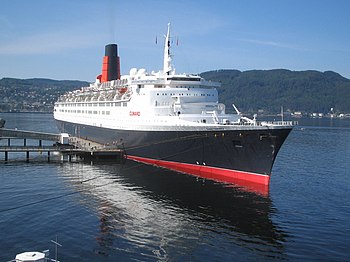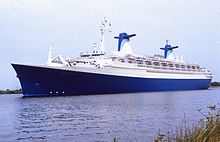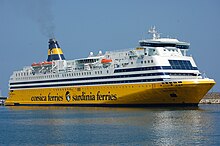Passenger ship
A passenger ship is a merchant ship, whose main function is the transport of passengers. The category does not include cargo ships that have accommodation for a limited number of passengers, such as the passenger freighters once common on the seas, where passenger transport is secondary to cargo transport. It does include, however, many classes of ships designed to transport both a considerable number of passengers and cargo. In fact, until recently virtually all ocean liners were capable of carrying mail and cargo, in addition to passenger baggage, and were equipped with cargo holds and cranes, or other cargo-handling equipment for that purpose. Only in more recent ocean liners and virtually all cruise ships has this cargo capacity been removed.
Although passenger ships are typically part of the merchant marine, passenger ships have also been used as troopships and are often commissioned as naval ships when they are expected to be used for such a purpose.
Types of passenger ships
Passenger ships include ferries, which are ships designed to make short voyages by day or night, carrying passengers and vehicles; ocean liners, which are normally passenger or passenger and cargo that travel a longer distance route; and cruise ships, which transport passengers on round trips, in which the trip itself, the ship and the places of interest visited by it are the main attractions of the voyage.
An ocean liner is the traditional form of passenger ship. In the past, such vessels operated scheduled liner trips to all inhabited parts of the world. With the advent of passenger transport planes and specialized cargo ships for the transport of goods, ocean liners have practically become extinct. But with its decline also came an increase in leisure travel, and in the latter part of the 20th century, ocean liners they gave way to cruise ships as the predominant form of large passenger ships, shifting the main sphere of activity from the North Atlantic Ocean to the Caribbean Sea.
Although some ships have characteristics of both types, the design priorities of the two types of ships are different: ocean liners generally counted on the value of speed and traditional luxury, while cruise ships Weight has shifted to facilities (swimming pools, theaters, dance halls, casinos, sports facilities, etc.) instead of speed. These priorities produce different layouts. In addition, ocean liners were normally designed for long voyages across the Atlantic Ocean, between Europe and the United States, or even to South America or Asia, while cruise ships tend to serve shorter routes with more stops along of the coasts, or between the various islands.
For a long time, the size of cruise ships was generally smaller than that of ocean liners, but in the 1980s, this changed when Knut Kloster, the head of Norwegian Caribbean Lines, bought one of the last surviving ocean liners, the SS France, and transformed her into a huge cruise ship, renamed Norway. Its success demonstrated that there was a market for large cruise ships. Orders were placed for successive classes of ships of this class, each time larger, until the Cunard Line's ocean liner RMS Queen Elizabeth was finally dethroned after a 56-year reign as the largest passenger ship ever built.
Both the RMS Queen Elizabeth 2 (QE2), in service from 1969 to 2008, and its successor, the Queen Mary 2 (QM2), which entered service in 2004, they are of mixed construction. Like the ocean liners, they are fast and strongly built to withstand the rigors of the North Atlantic on the liner route in service, but both ships are also designed to operate as cruise ships, with the amenities expected in such an arena. Royal Caribbean's MS Freedom of the Seas replaced Queen Mary 2 as the largest passenger ship ever built; however, QM2 still holds the record for the largest ocean liner ever built. In turn, the Freedom of the Seas was dethroned by the Oasis of the Seas, in October 2009.
Size of vessels
By convention, civil passenger ships are measured by gross tonnage, which is a dimensionless figure calculated from the total enclosed volume of the ship. Gross tonnage is not a measure of weight, although the two concepts are often confused. Weight is measured by cubic capacity, which is the conventional means of measuring naval ships. Often a passenger ship is declared to "weigh" or "move" a 'safe' tonnage, but the figure given almost always refers to gross tonnage, which in this context has nothing to do with its weight.
While a high displacement may better indicate her seakeeping capabilities, gross tonnage is touted as the most important measure of her size, as is gross tonnage per passenger – the ratio between passengers and the ratio of space – gives an idea of a ship's spaciousness, an important consideration on cruise ships where onboard amenities are of high importance.
Gross tonnage is normally much greater than offset value. This was not always the case; As the functions, engineering and architecture of ships have changed, the gross tonnage of the largest passenger ships has increased considerably, while the displacements of such ships have not. The White Star Line's RMS Titanic had a gross register tonnage of 46,329 TGR, could displace over 52,000 tons, and was heavier than contemporary 100,000–110,000 GT cruisers which displace only around 50,000 tons. Similarly, the Cunard Line's RMS Queen Mary and RMS Queen Elizabeth, of approximately 81,000–83,000 GT, but with displacements of over 80,000 tonnes, do not differ significantly in displacement from their new 148,528 GT successor, the RMS Queen Mary 2, which is estimated to displace approximately 76,000 tons. With the completion in 2009 of the Oasis of the Seas, the first ship in the Oasis Class, Cunard's iconic ships of the 1930s have been clearly outclassed in displacement, as the Oasis ships were designed to displace close to 100,000 tons..
However, by the conventional and historical measure of gross tonnage, there has recently been a dramatic increase in the size of the new largest ships. Oasis of the Seas measures in at over 225,000 GT, more than twice as large as the largest cruise ship of the 1990s.
Security checks
Passenger ships are subject to the two main requirements of the International Maritime Organization: carry out emergency drills for passengers (...) within 24 hours after boarding and be able to make a complete abandonment of ship, within a period of 30 minutes from the moment the abandon ship signal is given.
Design Considerations
Passenger vessels without backup generators can suffer substantial trouble due to lack of water, refrigeration and drainage systems in the event of the loss of main engines or generators due to fire or other emergency. In such a case, power would also not be available for the ship's crew to operate the electrically driven mechanisms. The lack of an adequate backup system to propel the ship, in rough seas, can cause it to drift and result in the loss of the ship. Review of safety standards and regulations on passenger ships facing these problems, and others, require that ships built after July 2010 comply with the new regulations for a safe return to port; however, many ships still remain in service that lack this capability.
Since October 1, 2010, the International Convention for the Safety of Life at Sea (SOLAS) requires that passenger ships operating in international waters must be built or upgraded to exclude combustible materials. It is believed that some of the owners and operators of ships built before 1980, who need to upgrade or withdraw their ships from service, will be unable to comply with the regulations.
External security measures
The International Ice Patrol was formed in 1914 after the sinking of the RMS Titanic to address the danger faced by passenger ships from collision with an iceberg.
Contenido relacionado
Submarine
Batport
Modulated amplitude







